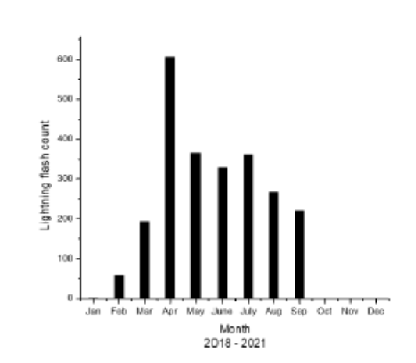


Indian Journal of Science and Technology
Year: 2023, Volume: 16, Issue: 9, Pages: 632-639
Original Article
Alka Gautam1, Vikram Singh1, Alok Sagar Gautam2*, Penki Ramesh Kumar3, Pushpendra Singh Soni1, Rolly Singh1, Surendra Pratap Singh4
1Department of Physics Agra College, Dr Bhimrao Ambedkar University, Agra, 282004, Uttar Pradesh
2Department of Physics, Hemvati Nandan Bahuguna Garhwal University (A Central University), Srinagar, Garhwal
3Department of Meteorology & Oceanography, Andhra University, Visakhapatnam, India
4Department of Physics, Dr B. R. Ambedkar Govt. Degree College, Mainpuri, 205001, Uttar Pradesh, India
*Corresponding Author
Email: [email protected]
Received Date:17 September 2022, Accepted Date:08 February 2023, Published Date:04 March 2023
Objectives: Lightning activity and its connections with meteorology and aerosol loading over Uttarakhand, with varying topography and climates, is studied using ISS Lightning Imaging Sensor (LIS) aboard international space station (ISS) data during the period 2018–2021. Methods: To understand the variation of lightning activity with meteorology and aerosol loading the correlation of lightning activity with different meteorological parameters such as surface temperature, convective available potential energy (CAPE), aerosol optical depth (AOD), and convective precipitation is studied. Findings: Very poor correlation is observed between lightning flash counts with the meteorological parameters. Annual variation of lightning activity over Uttarakhand shows maximum during the monsoon season (June–September) with a peak during the pre–monsoon season (March–May) month April. The high frequency of western disturbances defined as warm low-pressure systems associated with moisture originated over Mediterranean Sea travelling from west to east across the northern states are responsible for peak lightning activity during pre–monsoon month April and maximum lightning activity in the monsoon season is attributed to the monsoon convection. Novelty: The study made the spatio – temporal variation of lightning over Uttarakhand and also reveals the connection between lightning and different meteorological parameters in different climatic conditions of Uttarakhand which is first defining the importance of large-scale meteorological processes in the development of lightning in Uttarakhand.
Keywords: Lightning; Meteorological Parameters; Aerosol optical depth and Convective Available Potential energy (CAPE)
© 2023 Gautam et al. This is an open-access article distributed under the terms of the Creative Commons Attribution License, which permits unrestricted use, distribution, and reproduction in any medium, provided the original author and source are credited. Published By Indian Society for Education and Environment (iSee)
Subscribe now for latest articles and news.